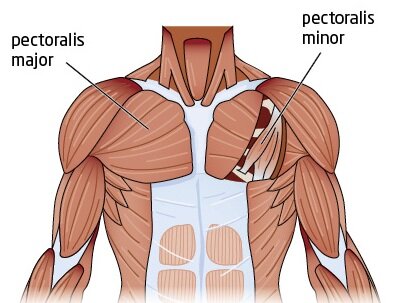Is sitting all day giving you tight pecs?
Do you sit at a desk all day or spend a lot of time looking down a a smart phone, tablet or laptop? Are your shoulders constantly rounded forward? Do you have back pain? You could have tight chest muscles (pectorals/pecs).
What are your pectoral muscles?
The pec minor is smaller and runs under the pec major. It goes from your ribs to your shoulder blades ad is mainly used to used to move your shoulder blades.
Together, your pecs play the important role moving your arms at the shoulder and your shoulder blades.
https://movestrongphysicaltherapy.com/new-blog/2019/11/18/tight-lats-do-this
https://www.healthline.com/human-body-maps/pectoralis-major-muscle#1
https://www.healthline.com/human-body-maps/pectoralis-minor#1
What causes tight pecs?
There are several causes but here are the main ones:
Poor Posture
A lot us spend a lot of time looking down for hours a day at a smartphone, tablet or laptop. As we spoke about before, our muscles tend to ada[t to their ‘normal’ position. When we hunch over our phones and computers, we encourage our shoulders to round and our upper back to fold forward. This can lead to tight pecs and street and weak upper back muscles.
Overuse
This tends to happen when people to a lot of upper limb exercises in the gym. A lot of people looking to get good ’t-shirt’ muscles tend to focus on exercise like chest and bench presses to increase the size of their pecs. However, they often neglect the opposing back muscles causing a muscle imbalance (the front pecs are stronger than the upper back muscles).
https://www.medicalnewstoday.com/articles/318897#causes
What happens if tight you have tight pecs?
As the pecs allow the movement of the arm at the shoulder, tight pecs can dramatically reduce the range of movement. It can also lead to:
Rounded shoulders
Neck pain, and
Pain the upper back and shoulders.
Also, due to the limited range of motion at the shoulder, the body will compensate and with repetition, this can cause:
Shoulder impingement
Bursitis, and
Rotator cuffs tears.
Do I have tight pecs?
This is best done by a physiotherapist on a therapy table and a professional assessment is recommended if you are experiencing pain. However, here is a variation you can do at home.
Lie on the floor on you back.
Place you hand directly out to the side of your body with a straight arm and your palm facing upward.
If your arm is unable to be flat on the ground (it remains hanging in the air), you may have a tight pec major muscles.
Repeat this with your above you in a V shape (45 degrees from straight above). This tests the length of you lower pec major and pec minor.
In the same position with your arms besides you, see if your shoulder is elevated above thee floor (rounded shoulders) this is likely due to a short or tight pec minor muscle.
What to do if you have tight pecs?
Firstly, if you are suffering pain, there are many medical causes, so please consult your health professional advice. Additionally, here are some things you can do to help prevent or release tight pecs.
Mobility
T, W and Snow Angel
This can be done either on the floor o for a greater stretch, on a foam roller (as shown here).
If you have a history of shoulder dislocation or instability, we recommend you remain on the floor variation. If you experience pain on the foam roller, move to the ground.
Keep your entire back on the floor or foam roller at all times (don’t let you lower back arch).
Lie on the floor or the foam roller with you head and tailbones supported.
For T: Place your arms out to eh side and allow gravity to draw them down (do not force them down).
For W: Bend both elbows and lower arms until they hang at your sides.
For Snow Angel: Gently move your arms out to the side and overhead like you are doing a snow angel.
Self-Myofascial Release
Standing Pec Trigger Ball Release
Place the release ball against the wall and lean your chest into the ball.
Move your body up and down and side to side.
Go slow and search for trigger points.
While maintaining pressure, you can also move your arm around.
Yoga
Cobra Pose
Lie on your stomach with your legs back and the tops of your feet on the floor.
Spread your hands on the floor under your shoulders.
Hug your bak into your body.
Press the tops of the feet and thighs firmly into the floor.
Begin to straighten your arms (Only go as high as your can with your pubis and legs on the ground. Only go has high as you can without feeling pressure or pain in your lower back).
Standing Chest Opener
Stand and clasp your hand behind your back.
Draw your shoulder blades together and feel the front of your chest open and stretch.
Swap your hadn’t clasp and do it again (often feel very awkward but is good for balancing the sides).
You can also do it with a towel or a yoga strap.
https://www.verywellfit.com/easy-stretches-with-a-strap-2696355
https://www.verywellfit.com/how-to-do-anterior-shoulder-stretch-3436426
Bow Pose
Lie on your stomach with your hands alongside your body.
Bend your knees and bring your heels as close to your butt as you can (keep your knees no wider than hip width).
Reach back with your hands and take a hold of your ankles.
Try and lift your heels away from your butt and lift your thighs away from the floor.
Draw the tops of your shoulders away from your ears.
Give this a go and see if you can loosen up your pecs.
You can also get your FREE 2 week Recharge trial and we’ll go through these techniques with you.







